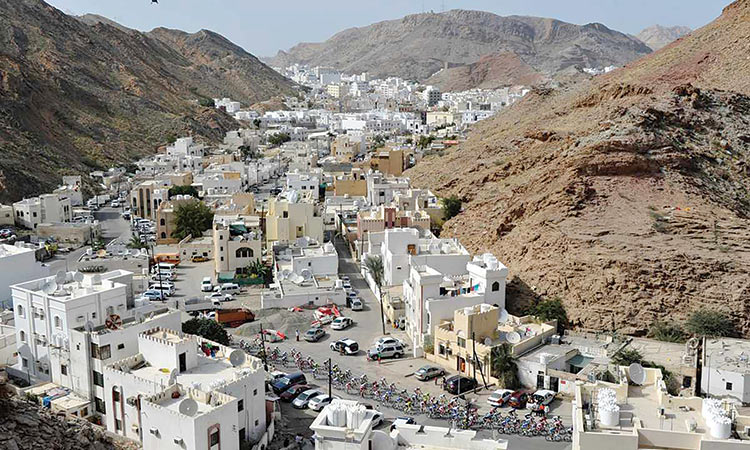Oman economy expects to grow by nearly 8 per cent in 2022

A general view of Oman. File/ Reuters
The World Bank’s Global Economic Prospects, which was published in January 2021, and forecasts the growth of developing countries around the world, Oman’s predicted rate also places it at the front of the GCC countries, in terms of potential growth.
At 11.8 per cent Niger is expected to grow fastest, according to the report. It is primarily African and Arab economies that are forecast to expand the most in 2022. Oman aside, the other countries forecast to grow are the Maldives (11.5 per cent), Ethiopia (8.7 per cent), Fiji (8.2 per cent), Iraq (7.3 per cent) and Djibouti (7.2 per cent).
Meanwhile Oman started selling US dollar-denominated multi-tranche bonds on Thursday, a document showed.
Oman is selling bonds with maturities of 10 and 30 years, and it re-opened $750 million bonds due in 2025, according to a document issued by one of the banks leading the deal.
Oman, rated below investment grade by all major credit ratings agencies, has piled up debt at breakneck speed over the past few years to cover widening deficits.
On Thursday, it started marketing the 10-year paper at around 6.625 per cent and the 30-year at 7.625 per cent-7.75 per cent, while the re-opening, or “tap”, of the 2025 bonds was marketed at around 4.875 per cent.
The bonds will be of benchmark size, which generally means upwards of $500 million per tranche, as the Gulf oil producer seeks fresh funding to cover a fiscal shortfall.
Oman is expected to raise $2 to $3 billion with the debt sale, a source familiar with the matter said. The ministry of finance did not immediately respond to a request for comment.
Citi, HSBC, JPMorgan and Standard Chartered have been mandated to coordinate the deal, which will be completed later on Thursday, the document said.
Oman is also raising funds in the bank market, sources told Reuters earlier this week, working with a group of banks to raise a $1.1 billion facility which could go up to $2 billion in size depending on market appetite.
Oman’s external debt maturing this and next year amounts to $10.7 billion, or about 7.5 per cent of gross domestic product, S&P Global Ratings has said.
It expects a 2021 budget deficit of 2.24 billion rials ($5.83 billion) this year and to make up the shortfall the government aims to raise about 1.6 billion through borrowing and draw 600 million from its reserves.
Oman Ministry of Economy has published details about the tenth five year plan (FYP), 2021-2026, which will also form the base budget for National Vision 2040.
Per the file published Tourism sector has taken a back seat, compared to other key sectors which has received more focus. High targets have been set for Education, Manufacturing, Transport and Logistics, Fishery Wealth and Mining.
Among others, Oman’s tourism sector was one of the most affected sectors in 2020 due to COVID-19 pandemic. The Ministry of Heritage and Tourism estimated the sector’s direct losses at about RO500 million till the end of September 2020. Domestic tourism in Oman is seeing an uptick currently as the cooler months are in fray with restrictions still in tow to travel abroad.
Oman’s education sphere is also undergoing a paradigm transformation in the methodologies of education offered, with the higher education scenario too witnessing positive changes in terms of admissions, scholarships and job-potential courses on offer for students.
Oman’s strategic position between Southeast Asia and Africa, its long coastline and its safe natural harbours, are strong and natural points to substantiate its pivotal position in transport and logistics. A target of 6.4 per cent of GDP has been set for sector of Transport and Logistics.
Oman’s growth rate is also significantly higher among the GCC countries: Kuwait (3.1 per cent), Qatar (3 per cent), Bahrain (2.5 per cent), the UAE (2.4 per cent), and Saudi Arabia (2.2 per cent)
Analysts say the country’s high forecast growth is justified, on account of new plans for achieving the goals of Vision 2040, which aims at sustained economic expansion and social development, as well as progress on existing plans aimed at growth.
Tanfeedh, the country’s economic diversification plan which aims to move Oman away from oil-and-gas-based sources of revenue, has identified five areas of expansion: agriculture and fisheries, mining and energy, logistics and transportation, manufacturing, and tourism.
Many of the Royal Decrees issued by Sultan Haitham Bin Tarik pertain to the economy and related sectors, as do the related ministerial decisions.







